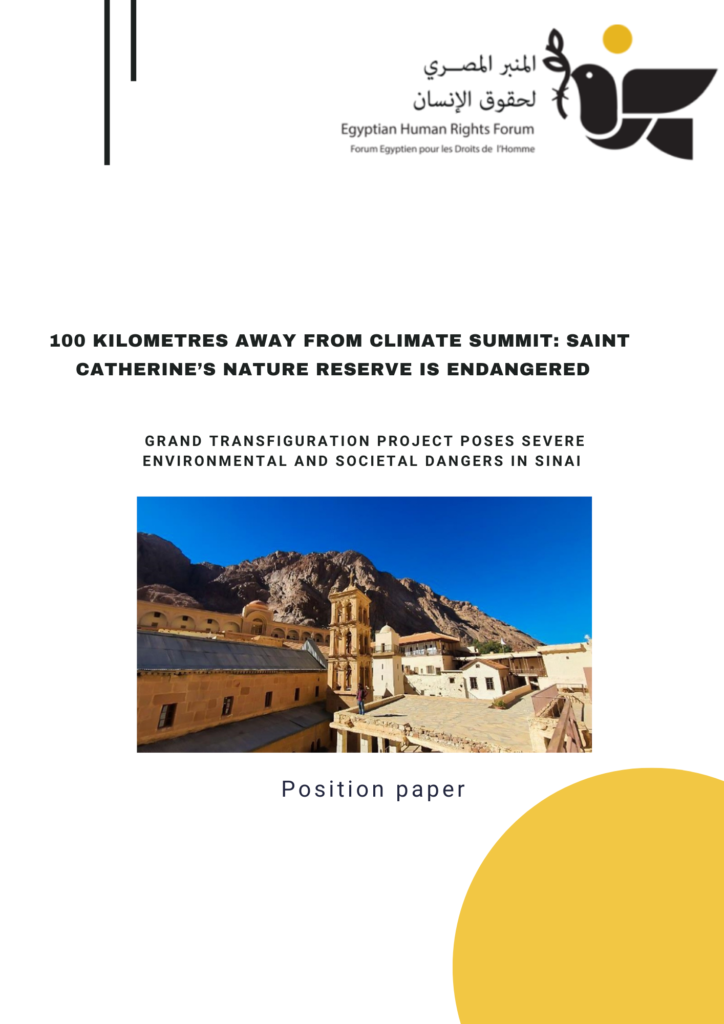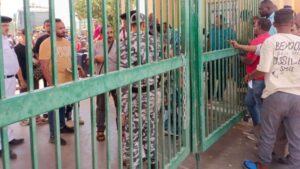Grand Transfiguration project poses severe environmental and societal dangers in Sinai
In March 2021, Egypt’s Ministry of Housing, Utilities and Urban Communities published an internal document titled “The Development of Saint Catherine, The Site of the Grand Transfiguration on the Land of Peace.” The official document included full details of a government plan to erect a mega-tourism hub across the World Heritage Site and the Nature Protectorate of Saint Catherine in the mountainous region of South Sinai, an area in which any forms of construction are heavily restricted by international regulations and treaties of heritage preservation, biodiversity and environment protection as well as the Egyptian laws and regulations of nature protectorates.
Weeks after the document was issued, a few thousand construction workers were deployed along with hundreds of construction vehicles and machinery to begin massive-scale demolition and construction works starting from the core area of the World Heritage Site around the ancient Monastery of Saint Catherine and spreading out into various parts of the nature protectorate. The sudden launch of this massive construction project was accompanied by a wave of news and media propaganda focused on President Abdelfattah Al-Sisi’s personal sponsorship of what is now officially dubbed the Grand Transfiguration Project.
Over the past year, hundreds of buildings have been erected in and around the historic town of Saint Catherine in clear violation of the UNESCO regulations of World Heritage Sites as well as Egypt’s domestic laws of nature protectorates. According to residents of Saint Catherine, as well as locally and internationally recognized heritage and environmental wealth experts, this project has forever distorted the historic town’s face and caused mass scale and irreversible damage to the area. The devastating impacts of this project, fully planned and executed by Egyptian government authorities and their contracted companies, are taking place 100 kilometres away or less from the world-famous resort of Sharm El-Sheikh where Egypt will host the United National Climate Change Conference, COP27, in November of this year.
The unprecedented damage to Saint Catherine, a unique site revered by hundreds of millions of people from all Abrahamic faiths worldwide, will go further unless this project is immediately shut down.
Five star hotels at Mount Sinai
Over the past year since the so-called development project of Saint Catherine was announced, the Egyptian state-controlled media has recurrently insisted on transforming the ancient town -known for the historic Saint Catherine Monastery, its Bedouin Jabaleyya tribe, and the climb up Mount Sinai- was planned carefully to preserve the heritage and environmental wealth of the area. But the details of the plan revealed by the Ministry of Housing’s document and the massive scale works on the ground show a different reality: a situation accurately described by one respected expert on Saint Catherine as “Criminal destruction.”
The Ministry of Housing’s document, which includes maps, graphic illustrations, and a full breakdown of the project, shows 14 parallel construction plans comprising hundreds of thousands of square meters of conventional construction. The following are some of the mentioned plans:
- Construction of the new ecolodge – 216 rooms, 16950 square meters of construction
- Construction of the mountain hotel – 150 rooms, 20855 square meters of construction
- Construction of the new visitors centre – 5876 square meters of construction
- Construction of the new administrative compound – 80 chalets, reception building and
- restaurant, shopping bazaars, social and cultural club
- Construction of the new housing district – 700 housing units
- Construction of the new tourist district – 440 Chalets, 450 villas, four hotels, 490 health and
- recovery chalets
- Construction of the roads and infrastructure network
The document stated that the government intends to increase the population of the town of Saint Catherine to 12000 people, almost double the current population. To service the massive surge of population and the new development, the Egyptian authorities began building a new highway that will connect the town of Saint Catherine with South Sinai’s administrative capital of Al-Tur on the Suez Gulf; the new highway is currently being constructed in the bed of Wadi Hebran, one of the most environmentally rich valleys of South Sinai and an active site of seasonal rain floods.
All experts on the heritage and environmental wealth of Saint Catherine, who were interviewed unanimously by the author in fear of Egypt’s infamous retribution against any form of opposition or dissent, confirmed that construction works of last year in the World Heritage Site and around the Saint Catherine Protectorate have caused “massive scale” and “irreversible” damage to the areas of ancient heritage and natural environment.
According to the experts, the construction of hundreds of new buildings will forever change the natural scenic views of the core area of Saint Catherine that hosts the 1500-year-old Monastery, a primary element that led to the 2002 UNESCO designation of the area as a World Heritage Site. In addition, the amounts of industrial pollution generated by the past year of construction works that creep to the walls of the Monastery are putting at risk already severely endangered and endemic plants and animals and are currently reversing and threatening years of heritage and environmental preservation efforts by Egyptian as well as international workers and NGOs, a prime example of such efforts is the ongoing preservation projects of the Saint Catherine Monastery, sponsored by the London based Saint Catherine Foundation, the royal patron of which is Prince Charles of Wales.
The severity of the situation brought together a group of Sinai and Saint Catherine experts, including the author of this report, in March of 2022, who collectively produced an open letter calling for the immediate stopping of the construction projects and the intervention of UNESCO and major heritage and environmental organizations in an attempt to rescue the area from the ongoing destruction.
“Unfortunately, in the absence of representation, the monastery was not informed of the Government’s intentions before the projects started,” one official of the Saint Catherine Monastery told the experts who produced the March 2022 statement. “The projects have an immense scale, and the situation is irreversible.”
Other experts and residents of Saint Catherine have confirmed in this report that the Egyptian authorities, including the Ministry of Housing, the Ministry of Environment and the Ministry of Tourism and Antiquities, did not hold any press conference or a meeting with community members and more broadly the expert institutions specializing in heritage and environmental preservation. Those statements shed serious doubts on the candidness of the propaganda campaign run by state-owned and sponsored media and continually praising the projects since their beginning in 2021.
One resident and keen observer of the situation on the ground in Saint Catherine reported that the authorities did not include the local community and institutions in the planning and execution of the so-called development project, and the atmosphere of fear of retribution from the authorities among the community left everyone, even those aware of the damage and destruction this project, left them helpless to take action.
“When the Government of Egypt requested that Saint Catherine be included on the list of World
Heritage Sites accepted the conditions for the inscription, which included preventing inappropriate
and unsustainable development within the boundaries of the World Heritage Site. The current tourism development now being carried out at pace is in total contravention of this agreement with UNESCO and must place the Saint Catherine Area on the list of World Heritage in Danger,” said John Grainger, former EU Project Manager for Saint Catherine Protectorate between 1996 and 2003.
Meanwhile, the damage caused by launching such development in Saint Catherine isn’t limited to the construction phase and the associated pollution and demolitions of obsolete parts of the town and protectorate but will continue and is expected to increase drastically. The intended rise of the resident population and a surge of incoming tourism will automatically generate amounts of pollution, waste and other wearing effects unseen before. It will continue to impact the fragile and, in many cases, endangered cultural and biological nature of the region. While the World continues to strive to lessen such impacts on cultural and natural protectorates, the Egyptian authorities are recklessly and quite ignorantly going doing the complete opposite.
A Besieged Local Community
For decades, the town and protectorate of Saint Catherine have maintained a unique nature almost entirely because of its ancient Monastery, Mount Sinai and the local community of the Jebaleyya tribe, known historically as the Guardians of the Monastery. The three elements comprise the attraction of this little mountainous town with unmatched natural beauty and wealth. This so-called development project, contrary to any progress it promises, brings an existential threat to the Bedouin population.
The complete lack of inclusion of the Jebaleyya community in the planning phases of this project was just the beginning. Since the construction started across their town, the local residents who’ve owned and lived in their mountain and valley homes for decades and their ancestors before them for hundreds of years have been left in a complete state of uncertainty about where they fit within this mega modern project. But the terrifying signs began almost immediately.
Today, the centre of the town of Saint Catherine has been completely razed, and the concrete structures are invading the ancient residential districts, forever changing the face of the proud Bedouin town in front of its defenceless population. Without any clear plans for homes and properties that would fall in the way of the new constructions, the local community were shocked by the destruction of the local cemetery, leaving families collecting the remains of their dead relatives through the night. In contrast, those whose houses were demolished and others whose homes are expected to be demolished are left without knowing how they will be compensated or helped rebuild their lives.
While this project might claim to generate jobs and provide an economic opportunity, the reality says otherwise. It is reminiscent of mass evacuations of entire towns and villages in North Sinai for security reasons and the total marginalization the Bedouins of South Sinai faced as the tourism resorts took over their ancient seafront lands. The world-renowned resort of Sharm El-Sheikh, where the United Nations Climate Change Conference is scheduled to take place this year, stands witness to the ruthless isolation the Bedouins community regularly face: the only development the Bedouin town of Al-Rowaisat on the edge of Sharm El-Sheikh received was a separation fence, and Egyptians filled the overwhelming majority of jobs in the tourism sector from all parts of the country and even foreigners from around the World but not the local Bedouin communities.
One resident of Saint Catherine explained that so far, no one knows where the local community falls within this significant development. It comes with five-star hotels and restaurants, pavements and concrete buildings, all of which pose the threat of driving the tourists away from the local Bedouins who provide their services of camel riding tours, simple, ecological accommodation in Bedouin guesthouses, and guiding the tourists on hikes though the valleys and a climb of Mount Sinai.
“I believe this niche kind of tourist, seeking Saint Catherine and its kind people who make the allure of this town, will continue to visit. But this development is being built to attract a different kind of tourist that requires a pampered experience which is not expected to be provided by the local community,” said the resident and observer of this project as it continues to transform the town.
Joseph Hobbs, a geography professor who wrote the book “Mount Sinai” after living in Saint Catherine for years, was among the experts who convened to expose this threat to the area.
“The master plan for developing this area would include sprawl pavement and infrastructure across and near these sacred places. The Abrahamic faithful and people searching for an inspiring wilderness will not want or need this profane development, which will result in the shameful de-listing of Saint Catherine as a World Heritage Site and perhaps in a tourist boycott,” says Hobbs.
COP27: Protecting the Environment or Enabling its Destruction?
This is a rare site revered and sought by people from all three Abrahamic faiths, Islam, Christianity and Islam. While Saint Catherine, the town, Monastery and Mount Sinai are all geographically located in Egypt, they all represent a shared human heritage and thousands of years of history lived and written by people from all faiths, colours and nationalities. For decades, such people and more have collaborated, Egyptians and foreigners alike, to work on enhancing the protection and preservation of this unmatched cultural, religious and environmental wealth.
Ironically, the 2022 United Nations Climate Change Conference “COP27” is set to be held in Sharm El-Sheikh, less than 100 kilometres from where such shameful destruction is taking place today. This convention of governments and non-governmental agencies coming together under various mottos and slogans of protecting and saving the planet, while various Egyptian officials continually boast that this project will be completed and launched before COP27 begins, raises serious questions about the choice of Egypt as the host country of the conference, its keenness, or lack of, on the principles and goals of such a global event, and more importantly about how such an internationally reputable event appears to enable Egypt’s authorities as they continue to violate and destroy cultural and environmental wealth.
The fact that the resident population of Saint Catherine and almost every source who was interviewed for this report remain anonymous out of fear of government retribution, even when they discuss a matter of heritage and environment that does not entail any political opposition or dissidence, is an adequate sign and an early signal of how qualified Egypt’s current authorities are to participate in COP27, let alone hosting the event.
“I think it’s ironic that this mass tourism development coincides with the COP27. However, this approach to development is not new to Egypt. We can see similar disregard in revamping the capital and protected landscapes all over the country,” said the resident of Saint Catherine, once again on anonymity, “a negligence toward the environment and a very outdated and wasteful way of developing for tourism.”
Another Egyptian environmental worker in Europe also chose to speak on the condition of anonymity as he said of the irony of such a destructive construction coinciding with COP27. He explained that one of the most concerning issues regarding this mega tourism project is the nonexistence of due process and transparency, which makes it impossible to know the extent of the damage the heritage and environment of Saint Catherine suffers.
“The human rights situation in Egypt does not allow for any dialogue or discourse over any sustainable progress, and therefore Egypt being the host of such an important event [COP27] is difficult. And the fact that such destruction is happening a few hundred kilometres away from the event is even more ironic and depressing.”
The participants of COP27, governments and independent institutions, have a responsibility to publicly acknowledge that “there is a deteriorating situation on the social and political fronts which is leading to the ongoing destruction of the social fabric as well as the destruction of natural and cultural wealth,” said the environmental worker.
Conclusion
The ongoing massive-scale construction of the tourism project dubbed by the Egyptian authorities “The Grand Transfiguration Project” has been launched without proper consultations with environmental and cultural preservation experts. This lack of due process has led to unprecedented levels of destructive effects on the World Heritage Site and the Nature Protectorate of Saint Catherine.
The severe damage caused by this project has been voiced even before the construction and demolition works began. Still, the Egyptian authorities, including the Ministry of Housing, the Ministry of Environment, and the Ministry of Environment, have ignored the warnings and their responsibilities. The Egyptian government, by launching and continuing this project, has knowingly violated laws and agreements, both domestic and international, that it has vowed to respect and work to abide by.
Given the current political atmosphere in Egypt, and its ruthless stifling of any forms of opposition, dissent or free speech, this project continues. At the same time, the local community, non-governmental organizations and independent experts are silenced by the threat of arrest, imprisonment and worse.
- Egypt has to immediately cease all construction works in and around the World Heritage Site and Nature Protectorate of Saint Catherine.
- An independent mission of environmental and heritage experts has to immediately begin assessing the damage caused by this project to its surrounding areas.
- The local community of Saint Catherine have to be immediately compensated for any losses caused to their properties by this project.
- UNESCO’s World Heritage Centre should immediately declare the area a World Heritage Site in Danger.
- UNESCO’s World Heritage Centre and UNESCO’s mission to Egypt have to begin immediate plans and works on stopping and containing the damage caused by this project.
- The London-based Saint Catherine Foundation has to immediately form and dispatch a mission to the Saint Catherine Monastery to assess the damage caused to the ancient buildings and their surroundings.
- The upcoming United Nations Climate Change Conference has to publicly recognize the gravity of the situation in Saint Catherine and dedicate a part of its agenda to discussing it with specialized parties to stop the ongoing destruction and find a possible solution.
To download and read the paper: https://www.egyptianforum.org/wp-content/uploads/2022/08/English-final-.pdf









